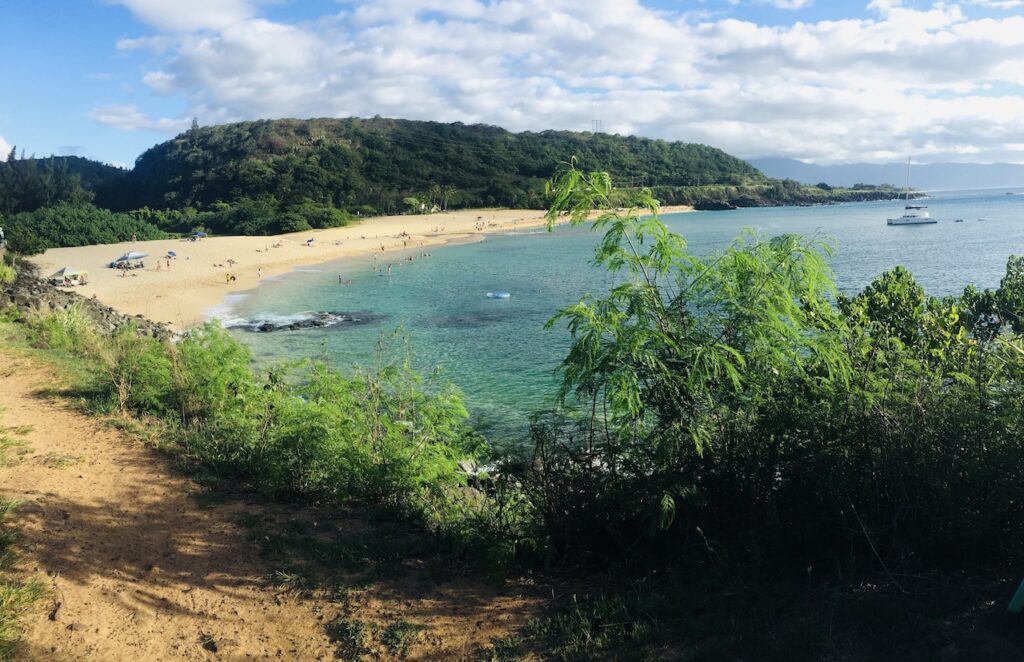Ever wonder what it’s like to visit or live in Hawaii? Oahu is a place where the past and present collide—from ancient Hawaiian traditions to modern-day culture. It’s an island where you can hike a volcanic crater in the morning, enjoy fresh poke for lunch, and surf world-famous waves by afternoon. After my 3-month internship on the island of Oahu, here’s my breakdown of the island and my top recommendations.
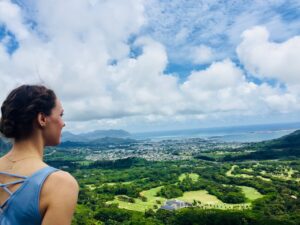
Hawaiian Culture and History
In my opinion, visiting Hawaii feels like being in a foreign country, even though it’s still part of the U.S. Oahu, in particular, blends native traditions with global cultures. Native Hawaiian practices like hula, luaus, and traditional music are still celebrated. And values like aloha (love) and ohana (family) guide daily interactions. But at the same time, I had some of the best Thai and Korean food there.
Hawaii became a U.S. state in 1959. Before that, the Kingdom of Hawaii was ruled by monarchs like King Kamehameha I, who unified the islands in 1810. While Western influences shaped modern Hawaiian society, native traditions still remain.
Preserving Hawaiian Culture Today
Hawaiians work hard to preserve their traditions. Hawaiian language is taught in schools, with a focus on revival. The Hawaiian Immersion Program helps children learn both Hawaiian and English.
Hula, once a sacred art, is now taught to many children. Where I’m from, most kids learn ballet or tap. In Hawaii, though, many children grow up learning hula. Surfing, another deeply rooted Hawaiian tradition, is also passed down through generations. Children often start surfing young, connecting with the ocean in a way that’s central to Hawaiian life.


Oahu’s Unique Place in Hawaiian History
Oahu is the political, economic, and cultural heart of Hawaii. Honolulu, the capital, has always played a pivotal role in trade and culture. Oahu is also home to Pearl Harbor, one of the most significant historical sites in the U.S. It blends both traditional Hawaiian and international influences.
Oahu’s history is marked by waves of immigration, particularly from Asia. Many immigrants came to work on the sugar plantations, shaping the island’s multicultural landscape. Today, Asian cultures—especially Japanese, Chinese, and Filipino—are prominent in Oahu’s food, festivals, and neighborhoods. Oahu is a melting pot, especially with its large Asian population. The Aloha spirit, which values kindness and hospitality, unites all cultures on the island.
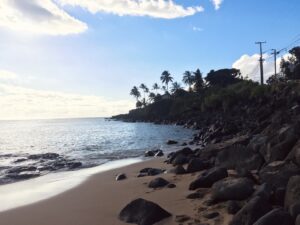
How Oahu Differs From the Other Islands
Hawaii has 8 main islands: Hawaii (Big Island), Maui, Oahu, Kauai, Molokai, Lanai, Niihau, and Kahoolawe. Oahu is the most urbanized island, blending modern city life with beautiful island landscapes. The other islands each offer unique experiences:
- Maui: Known for its luxury resorts. Maui also features the Haleakalā National Park, home to a dormant volcano. The island’s scenic Road to Hana is a must-drive, winding through rainforests, waterfalls, and beaches. Maui is perfect for those seeking both adventure and relaxation.
- Kauai: Often referred to as the “Garden Isle,” is famous for its tropical landscapes. The island is home to the breathtaking Na Pali Coast, accessible only by foot, boat, or helicopter. Kauai is also known for its dramatic waterfalls, such as Wailua Falls, and its diverse hiking trails.
- Big Island: One of the major highlights is Hawaii Volcanoes National Park. The island is known for its diverse climates, ranging from arid deserts to lush rainforests. Visitors can explore active volcanoes, black sand beaches, and tropical waterfalls.
- Moloka’i: Moloka’i is known as the most traditional of the Hawaiian Islands, with a slower pace of life and fewer tourists. It was once home to a leper colony, which operated until 1969.
- Lanai: Known for its secluded resorts and unique landscapes. The island offers a peaceful escape, perfect for those looking for tranquility away from the more crowded islands. Lanai’s rugged terrain and exclusive resorts make it an ideal destination for luxury travelers seeking privacy and natural beauty.
- Niihau: Known as the “Forbidden Island,” Niihau is privately owned, and access is limited to invited guests and residents, mostly Native Hawaiians. Niihau remains largely untouched by modern development.
- Kahoolawe: Once used as a military training site, Kahoolawe is now being restored but remains mostly uninhabited. The island is off-limits to most visitors, except for those involved in cultural and conservation efforts. Efforts are underway to restore the land, making it an island of historical significance and a symbol of environmental and cultural healing.
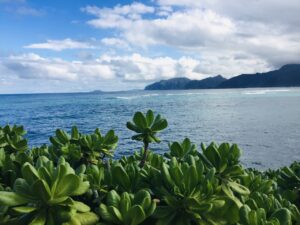
Most Popular Islands to Visit
The most popular islands for visitors are Oahu, Maui, and the Big Island.
Oahu draws tourists for Waikiki Beach, Pearl Harbor, and its vibrant cultural scene.
Maui is famous for luxury resorts, the Road to Hana, and Haleakalā’s sunrise.
Big Island attracts adventure seekers with active volcanoes, diverse ecosystems, and hiking trails.
Oahu remains the most visited island due to its commercial development and numerous attractions.
What to Eat
Poke, marinated raw fish, is a beloved dish in Hawaii. Tuna and salmon are common, seasoned with soy sauce, sesame oil, and seaweed. If poke isn’t for you, Hawaiian BBQ offers delicious grilled meats like kalua pork and teriyaki beef, served with rice and macaroni salad. Another favorite is loco moco, a comfort food made of rice, a hamburger patty, a fried egg, and brown gravy.
Poi, made from mashed taro, is a traditional side dish with a smooth, slightly sour taste. It’s often served at large feasts or alongside savory dishes.
For something sweet, try shave ice, finely shaved ice topped with colorful syrups. Haupia, a coconut-based dessert, is often served as pudding or pie at luaus. Macadamia nuts are also a local favorite, often roasted, salted, or coated in chocolate. Malasadas, Portuguese-inspired doughnuts, are deep-fried and coated in sugar.
For breakfast or a snack, try apple bananas, a smaller, sweeter variety. Kona coffee, grown on the Big Island, is famous for its smooth, rich flavor. Finally, no visit to Oahu is complete without fresh pineapple, the island’s iconic fruit.
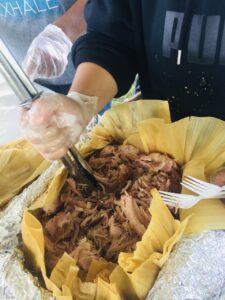
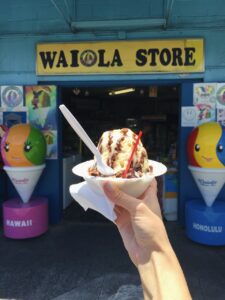
Hawaiian Coffee
Hawaiian coffee, particularly Kona coffee, is famous for its distinct smooth flavor. Kona coffee grows in volcanic soil on the Big Island. Warm days, cool nights, and regular rainfall create ideal conditions. The volcanic soil is rich in minerals, which enhance the coffee’s flavor.
Kona coffee has low acidity and features notes of chocolate, nuts, and fruit. The beans are hand-picked to ensure only the ripest cherries are used. After being sun-dried, the beans are lightly roasted to bring out their natural flavors. Kona coffee remains the most famous Hawaiian coffee variety, though other regions also produce high-quality beans.
Famous Beaches in Oahu
Oahu has many iconic beaches, each offering something special:
Famous Beaches in Oahu
Oahu has many iconic beaches, each offering something special:Waikiki Beach is known for its soft sand and clear water. It’s great for surfing and swimming.
Lanikai Beach is famous for its white sand and turquoise waters. It’s perfect for swimming and kayaking.
Waimea Bay is known for big waves in winter, attracting experienced surfers. In summer, it’s great for swimming.
Sunset Beach is famous for breathtaking sunsets and large waves. It’s perfect for watching surfers.
Ala Moana Beach Park is family-friendly with calm waters and scenic park areas.
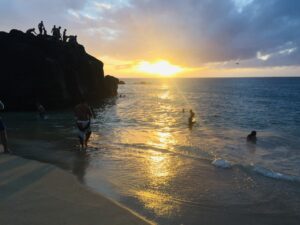
My Top Recommendations
Waikiki Beach and Surrounding Area
Waikiki Beach is one of the most popular spots on Oahu, offering great views of Diamond Head and the Pacific Ocean. It’s perfect for swimming, surfing, or just relaxing on the beach. The area also has a lively atmosphere with plenty of shops, restaurants, and bars. If you’re new to surfing, this is a great place to take lessons, as the waves are gentle and consistent. While you’re there, be sure to check out the Royal Hawaiian Hotel and Fort DeRussy Park, which are both significant landmarks in the area.
Hiking Diamond Head and Koko Head
If you love hiking, don’t miss the trails at Diamond Head and Koko Head. The Diamond Head hike is one of the most famous on the island. It’s a moderate 1.6-mile trail that takes you to the top of the volcanic crater. Unfortunately, the trail was closed when I was there due to volcanic activity on the Big Island, so I did not have the chance to experience it. On the other hand, Koko Head is a more challenging hike, with over 1,000 steep steps leading to a panoramic view of the island’s southeastern coast. I did the Koko Head hike in my early 20s and, despite being in good shape at the time, I found it tough. I had to take several rest breaks along the way, but the view from the top was totally worth it. After completing the hike, reward yourself with a delicious brunch at Koko Head Café, where we had the macadamia nut pancakes and cornflake French toast.
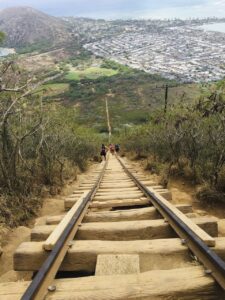
Pearl Harbor National Memorial
If you’re interested in history, a visit to Pearl Harbor is essential. The Pearl Harbor National Memorial honors those lost in the 1941 attack. The USS Arizona Memorial offers insight into the events leading to the United States’ involvement in World War II. You can also visit the Battleship Missouri, where Japan officially surrendered, and the Pearl Harbor Aviation Museum, which features historical aircraft and exhibitions related to the attack.
Ko Olina Resort Area
For a more laid-back experience, Ko Olina is a great choice. Located on Oahu’s western coast, this area is home to peaceful man-made lagoons perfect for swimming. It’s a quieter spot compared to the hustle and bustle of Waikiki, making it ideal for those looking to relax. Ko Olina also has several upscale resorts like the Four Seasons and Aulani, A Disney Resort & Spa, where you can enjoy fine dining, luxurious amenities, and spa treatments without the crowds.
Polynesian Cultural Center: Luau and Show
Many locals recommended the Polynesian Cultural Center during my time in Hawaii. Located in Laie on the north shore, this center offers an authentic Hawaiian luau experience. You can enjoy traditional Hawaiian food, music, and dance, as well as explore cultural villages that highlight arts, crafts, and traditions from different Pacific Island cultures. The evening concludes with a performance that features dancers, musicians, and fire performers sharing stories from the Polynesian islands.
Surfing on the North Shore
Oahu’s North Shore is famous for its large waves, especially during the winter months. It’s known as the birthplace of modern surfing and hosts some of the world’s most famous surf spots, like Waimea Bay, Pipeline, and Sunset Beach. If you’re interested in surfing, it’s a great place to take lessons, even if you’re a beginner. After surfing, stop by Ted’s Bakery for a treat. Their chocolate haupia pie, made with coconut and chocolate filling, is a local favorite.
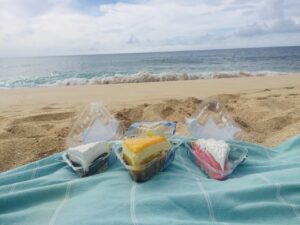
Shark Cage Diving on the North Shore
If you’re seeking adventure, try shark cage diving on the North Shore. This activity allows you to get close to sharks in their natural environment. Several companies offer tours where you can go down into a cage and observe sharks swimming around. The most common sharks you’ll encounter are Galapagos sharks and Hammerheads. The guides assured us that Galapagos sharks aren’t aggressive, and we found them to be quite curious but harmless, swimming near the cage for a quick look before swimming away.
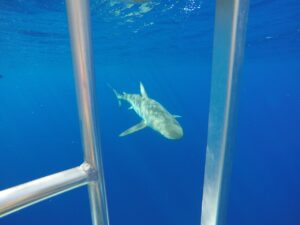
Conclusion
As is common with most visitors to Hawaii, Oahu will always have a special place in my heart after my time there. For more of our adventures and recommendations, check out these other posts:
US National Park Roadtrip: Arizona, Utah and Colorado
